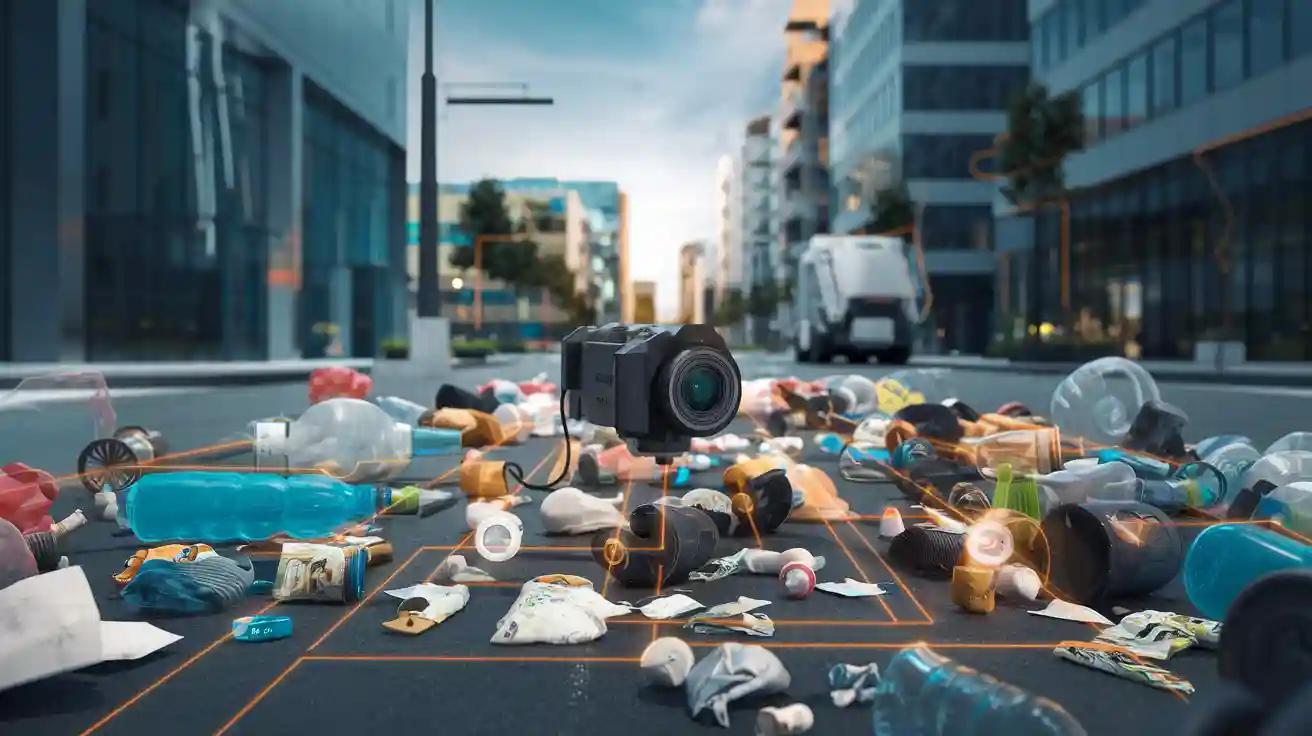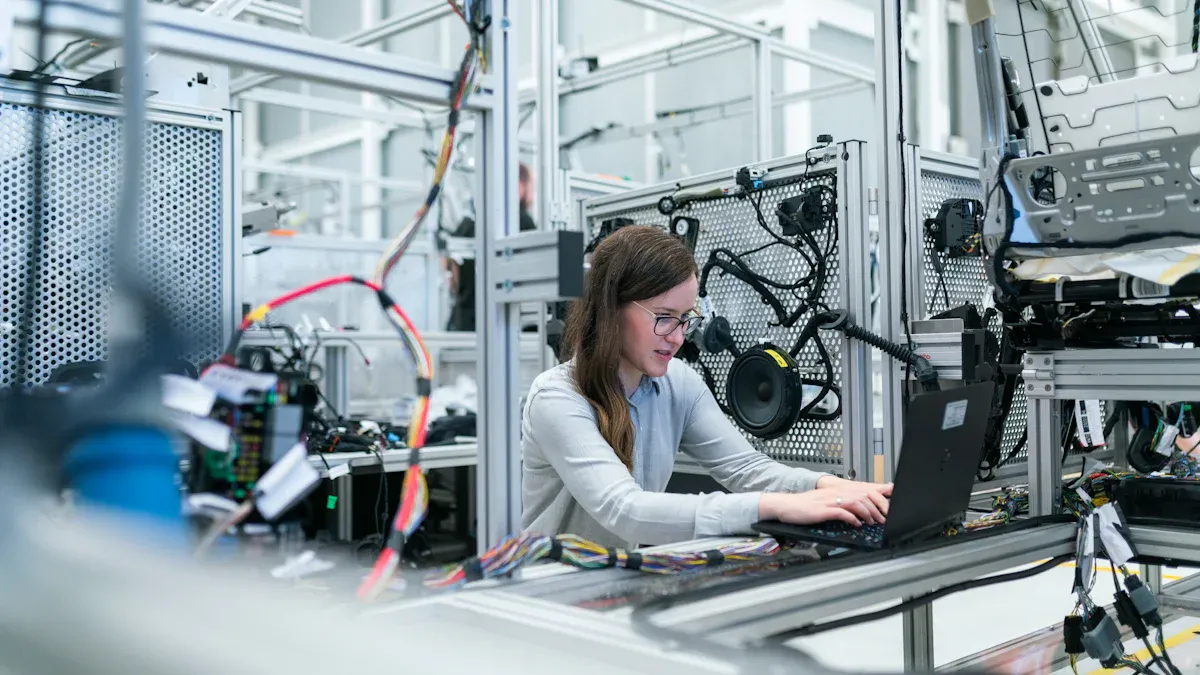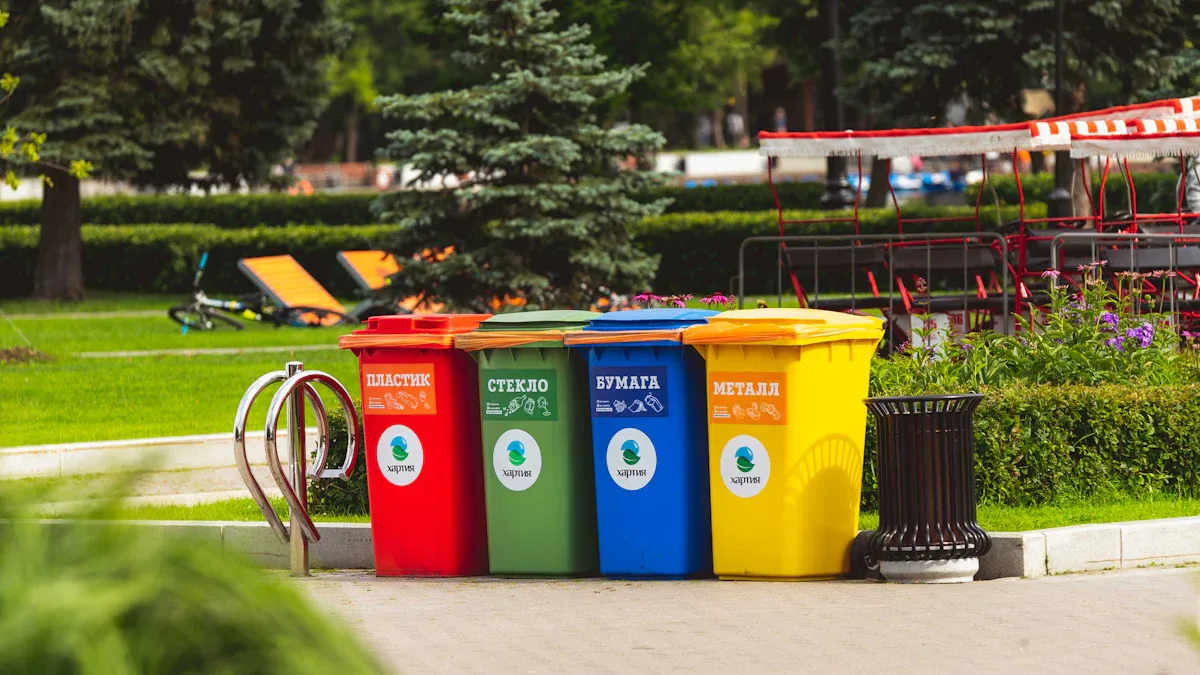
Poor-quality data in a garbage in machine vision system can cause big problems for city waste operations. When a machine receives unclear images or wrong inputs, the system may miss waste pickups or sort trash incorrectly. These mistakes can lead to overflowing bins and health risks for city residents. Reliable machine vision and computer vision in waste management help cities stay cleaner. Smart waste bins collect better data and help machines work more efficiently.
Key Takeaways
- Poor-quality data in machine vision systems causes errors in waste detection and sorting, leading to overflowing bins and health risks.
- Smart waste bins with sensors and cameras improve data accuracy and help cities collect waste on time, keeping neighborhoods cleaner.
- Regular calibration and staff training ensure machine vision systems stay accurate and reduce costly mistakes in waste management.
- Advanced computer vision and AI technologies boost recycling rates by sorting waste faster and detecting hazardous materials safely.
- Investing in new waste management technologies saves money, lowers emissions, and supports cleaner, healthier cities.
Garbage In Machine Vision System
What Is Garbage In?
Garbage in machine vision system refers to the entry of poor-quality or incorrect data into automated waste management tools. When a machine receives unclear images or incomplete information, it cannot accurately identify or sort waste. For example, construction and demolition waste often appears as mixed piles, making it difficult for image classification algorithms to recognize each component. Researchers use deep neural networks trained on large datasets, such as TrashBox, to help machines learn to classify different types of trash. These models use advanced features like residual connections and depth-wise separable convolutions to improve accuracy. However, RGB images alone sometimes fail to capture enough detail, especially in outdoor or long-distance scenarios. To address this, some systems use depth cameras to collect both color and depth data, allowing for better labeling and contour recognition. Despite these advances, hardware limitations and the complexity of real-world waste continue to challenge the effectiveness of garbage in machine vision system.
Data Quality Challenges
Urban waste management faces several data quality challenges that impact the performance of garbage in machine vision system:
- Absence of a central and integrated waste data recording system.
- Lack of unified records for waste reservoirs, collection times, and routes.
- Weaknesses in staff training and capacity to use new technologies.
- Poor integration of monitoring within the waste management cycle.
- Insufficient infrastructure for data collection and processing.
- Low efficiency and frequent waste collection, which reduces data reliability.
- Failure to follow international standards and regulations in data management.
Note: Accurate, reliable, and standardized data forms the backbone of effective machine vision. Without proper validation, documentation, and integration, even the most advanced machine cannot deliver consistent results. These challenges highlight the need for better data practices and robust systems to support cleaner cities.
Consequences for Machine Vision
Detection Errors
Detection errors often occur when a system receives unclear or low-quality images. These errors can cause the machine to misidentify objects in the waste stream. For example, a camera might capture a blurry image of a plastic bottle mixed with paper. The object detection algorithm may label the bottle as paper, leading to incorrect sorting. In one city, a pilot project used cameras to monitor street bins. The system failed to recognize glass bottles during rainy weather because water droplets distorted the images. As a result, the bins overflowed with unsorted glass, creating safety hazards for pedestrians.
Real-world experience shows that detection errors can quickly multiply. When a system misses one item, it often misclassifies others in the same batch. This chain reaction reduces the accuracy of waste classification and increases the cost of manual checks.
A table below summarizes common detection errors and their impacts:
| Error Type | Example Scenario | Impact on City Cleanliness |
|---|---|---|
| Mislabeling | Plastic as paper | Incorrect recycling, more waste |
| Missed Detection | Glass not detected | Overflow, safety risks |
| Double Counting | Same item counted twice | Data inaccuracy |
Missed Waste Sorting
Missed waste sorting happens when the system fails to separate different types of trash. This problem often starts with poor data quality. For instance, if the camera angle is wrong or the lighting is poor, the object detection model cannot see all items clearly. In a case study from Singapore, smart bins struggled to sort food waste from packaging during nighttime hours. The bins used a basic object detection system that could not handle shadows or overlapping items. As a result, food waste mixed with plastics, making recycling impossible.
Missed sorting leads to several problems:
- Recyclable materials end up in landfills.
- Hazardous waste contaminates regular trash.
- Cities spend more money on manual sorting and cleanup.
City officials in Barcelona reported that missed waste sorting increased landfill use by 15% in one year. They traced the problem to outdated cameras and poor calibration in their machine vision system.
Waste classification depends on accurate object detection. When the system fails, the entire process breaks down. Cities must invest in better cameras, regular calibration, and staff training to reduce these errors.
Computer Vision in Waste Management

Automated Waste Sorting
Cities now rely on computer vision in waste management to improve sorting accuracy and speed. Automated waste sorting systems use cameras, sensors, and advanced algorithms to identify materials like plastics, metals, paper, and glass. These systems process large amounts of waste quickly, reducing the need for manual labor. Robotics and machine learning work together to move and sort items on conveyor belts. AI-powered computer vision in waste management uses large datasets to train models for precise waste classification. This technology helps cities increase recycling rates and lower operational costs. Visual inspection technology also plays a key role by checking the quality of sorted materials before they leave the facility. Automated waste sorting reduces human error and ensures cleaner recycling streams.
Tip: Regular updates to machine learning algorithms keep sorting systems accurate as new types of waste appear in cities.
Contaminant Detection
Contaminant detection has become more effective with computer vision in waste management. Cameras and sensors capture images of waste, while machine learning algorithms analyze and sort materials into categories like plastics, glass, paper, and organic waste. Even small amounts of non-recyclable material can spoil entire recycling batches, so precise object detection is critical. Modern systems use object detection models such as YOLO11 to identify and classify waste in real time. These models spot hazardous items like batteries and e-waste, improving safety and compliance with regulations. They also help track waste for inventory management and detect illegal dumping through public camera analysis.
- YOLO11 detects different waste types on conveyor belts, reducing contamination.
- The model identifies hazardous materials, supporting safer waste handling.
- It counts waste items for better inventory control.
- YOLO11 monitors waste in public spaces and natural environments, such as along railway tracks or in the ocean.
- The system enables quick response to illegal dumping by analyzing images from city cameras.
Computer vision in waste management continues to advance, making recycling safer and more efficient for everyone.
Smart Waste Bins and Solutions

Data Collection Best Practices
Smart waste bins rely on accurate data to keep cities clean and efficient. Operators use several best practices to improve data quality and system performance:
- Ultrasonic sensors measure waste volume inside bins. These sensors help determine when bins need emptying. Studies show that ultrasonic sensors provide reliable measurements, with errors usually between 5% and 10%.
- Combining different sensors, such as temperature, weight, and cameras, increases data accuracy. This approach helps the system detect fill levels and waste types more precisely.
- Real-time monitoring with threshold-based alerts allows for timely waste collection. When bins reach a set fill level, the system sends notifications to collection teams.
- Deep learning models, like Yolov5 and Yolov8, analyze images from cameras above bins. These models classify waste types and estimate fill levels with up to 96% accuracy. However, lighting and weather can affect results.
- Operators face challenges, including the need for reliable power, system integration, and ongoing human maintenance. They address these by using scalable technology and phased rollouts.
- Data from smart waste bins supports better collection schedules and helps cities plan for recycling and sustainability.
Tip: Real-time data collection and sensor integration prevent bin overflow and support cleaner neighborhoods.
System Calibration
Regular calibration keeps automated waste management systems accurate. In-line verification technologies allow for continuous health checks without stopping operations. These checks reduce risks and ensure that sensors and instruments work correctly. Certified verification methods meet international standards, such as ISO 9001 and IEC 61511, which helps cities maintain compliance and traceability.
Operators use AI-assisted calibration to automate the process and reduce human error. AI reviews large amounts of sensor data, detects anomalies, and supports better decision-making. In-line diagnostics track performance over time and provide early warnings if instruments drift from their settings. Regular calibration, combined with digital tools, ensures that data remains reliable and that automated systems deliver accurate results.
Regular audits and staff training play a key role in maintaining system accuracy. Well-trained teams can spot issues early and keep technology running smoothly.
Future of Automated Waste Sorting
Emerging Technologies
New technologies continue to transform automated waste sorting. Cities and companies now use advanced tools to improve recycling and reduce waste.
- AI-powered waste management systems use sensors, cameras, and smart algorithms to sort trash with high accuracy. These systems help cities recycle more and send less waste to landfills.
- Robotic arms work alongside these systems to pick and sort items quickly and safely. This teamwork increases speed and lowers the risk of injury for workers.
- Machines like the Gradeall MKII Tyre Baler automate tire recycling. They can process up to six tire bales per hour and reduce the size of waste by up to 80%. This makes storage and transport easier.
- The G90 waste compactor uses Intelli-Fill technology to track how full bins are. It helps plan collection routes and saves money on fuel and labor.
- Smart bins with sensors and solar-powered compactors keep streets cleaner and safer. Some bins use AI to recognize and sort recyclables automatically.
- In 2023, AI-driven sorting systems made up over 38% of the AI waste management market. North America led this trend, showing strong investment in smart waste solutions.
Tip: Cities that invest in these new technologies see cleaner streets, lower costs, and better recycling rates.
Continuous Improvement
Continuous improvement keeps waste management systems effective and up to date. Cities use several strategies to make sure their systems get better over time.
| Aspect | Description | Impact on Continuous Improvement Practices |
|---|---|---|
| IoT-Enabled Smart Waste Systems | Sensors on bins monitor waste and help plan better collection routes. | Data-driven changes prevent overflow and cut costs. |
| Technological Advancements | Automated lids and smart communication tools make waste collection faster and more reliable. | New features support ongoing upgrades and better results. |
| Community Engagement | People help shape waste policies and give feedback, as seen in projects like UrbanWINS. | Community input leads to flexible and improved waste solutions. |
| Policy and Framework Development | New rules and partnerships support smarter, greener waste management. | Policies create a strong base for future improvements. |
| Case Studies | Cities like Stockholm and Adelaide use data and set recycling goals to guide progress. | Real-world examples show how continuous improvement works in practice. |
Recent studies show that robots in waste sorting learn and get better over time. Projects like HR-Recycler prove that ongoing updates in AI and robotics lead to safer, cleaner, and more efficient cities. Automation also reduces the need for garbage trucks, lowers emissions, and frees up space in busy areas. These changes make cities quieter, cleaner, and more flexible for future growth.
Cities achieve cleaner environments when they address data quality in machine vision systems. Reliable data and advanced technologies drive better waste sorting, lower emissions, and resource savings. Integrated waste management reduces government costs and supports urban sustainability. Regular audits and staff training boost recycling rates and cut labor hours by up to 40%.
| Benefit | Economic Impact | Environmental Impact |
|---|---|---|
| Smart waste solutions | ROI in 18 months, $2M savings | 80% emission reduction, less landfill |
City leaders and technology providers should prioritize smart waste solutions for a healthier future.
FAQ
What does "garbage in" mean in machine vision systems?
"Garbage in" means poor-quality or incorrect data enters the system. This data causes errors in waste detection and sorting. Reliable input ensures accurate results and cleaner cities.
How do smart waste bins improve city cleanliness?
Smart waste bins use sensors and cameras to monitor fill levels and waste types. They send alerts for timely collection. This technology reduces overflow and keeps public spaces cleaner.
Why is regular calibration important for automated waste systems?
Regular calibration checks and adjusts sensors and cameras. This process keeps data accurate and prevents errors in sorting. Well-calibrated systems help cities maintain high recycling rates.
Can machine vision systems detect hazardous waste?
Yes. Advanced machine vision systems identify hazardous items like batteries or chemicals. These systems use AI models to spot dangerous materials and support safe waste handling.
What challenges do cities face when using machine vision for waste management?
Cities face challenges like poor data quality, outdated equipment, and lack of staff training. Addressing these issues improves system performance and supports cleaner urban environments.
See Also
An In-Depth Look At Cameras Used In Machine Vision
A Beginner’s Guide To Sorting With Machine Vision Technology
Does Filtering Improve The Accuracy Of Machine Vision Systems
Key Reasons Machine Vision Systems Are Vital For Bin Picking
A Comprehensive Overview Of Inspection Vision Systems In 2025









